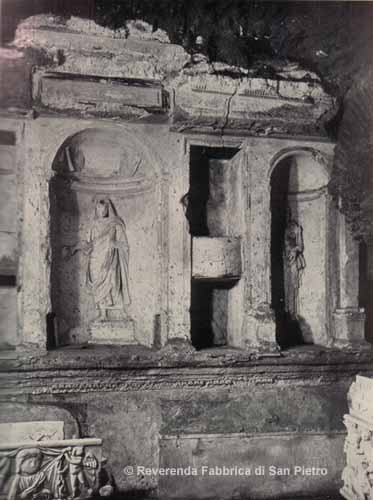
Niche,
showing the stucco figure of a veiled man, in the Tomb
of the Valerii
From 'The Shrine of St. Peter' by Toynbee and Perkins,
Pantheon. 1957 |
The
Tomb of the Valerii (Tomb H)
The
largest mausoleum of the whole series, H, with its
forecourt H1, is the family-tomb of the Valerii.
Writing-materials
are rendered in stucco above the heads of two of the
family-portraits in the Tomb of the Valerii. We cannot
tell whether this means that these people were professional
writers and men of letters, or that they merely devoted
their leisure-moments to literary pursuits.
|
From:
'The Shrine of St. Peter' by Toynbee and Perkins, Pantheon.
1957
Inscriptions throw some light upon the arrangements sometimes
made with regard to the ownership of tombs or of individual
burial-sites inside them. In the Tomb of the Valerii, Valerius
Philumenus and Valeria Galatia gave Titus Pompeius Successus
a locus in the tomb in which he might bury his son and their
friend, the free-born Titus Pompeius Successus junior.
Subsequent
restorations undertaken in the Tomb of the Valerii brought
further inscriptions to light. These inscriptions record,
among others, Aurelia Charite and her father Aurelius Psittacus;
Aurelius Helius and his wife Satria Ianuaria; and Flavius
Statilius Olympius, a Christian, whose delightfully illiterate
epitaph incorporates the Chi-Rho monogram. The inscription
recording Flavius Diodorus and his wife Selenia Berenice,
previously known only in a fragmentary state, is now complete;
the phrase comparaverunt libertis libertabusque posterisque
eorum, which it contains, may refer to the purchase either
of a whole tomb or of a burial-site within a tomb. A second
inscription of Flavius Diodorus and Selenia Berenice records
their infant grandson Flavius Velenius Diodorus, and alludes
to the purchase mentioned in the first inscription.
From:
'The Tomb of St Peter' by Margherita Guarducci, Hawthorn
Books, 1960
Corresponding to this variety of ideas about life beyond
the tomb there is a veriety of religious currents which
met and mingled at this time. This variety is well demonstrated
in the plaster ornaments in the tomb of the Valerii. There,
beside Minerva, the wise goddess of Olympus, can be seen
Isis, Apollo Harpocrates and Jupiter Dolichenus, three exotic
divinities very dear to the Romans of the imperial period;
while satyrs and maenads proclaim, with their frenzied dances,
the invincible power of that Dionysus-Bacchus whom the pagan
society of the time considered a symbol of supreme happiness
in earthly life and also in the future world. It might even
be said that the religion of Dionysus predominates in this
silent city of the dead. The young Dionysus, with his cortege
of satyrs and maenads, his panthers and his thrysus and
his festive, heavily-loaded bunches of grapes, seems to
promise, from the walls of tombs and from the carvings on
marble saracophagi, the end of troubles in an eternal happy
drunkenness.
From:
Zenit.org
VATICAN CITY, MAY 27, 2008 (Zenit.org).- One of the most
important monuments of the Roman necropolis located under
the Vatican Basilica is restored and ready for viewing.
During
a press conference today, Cardinal Angelo Comastri, archpriest
of the Basilica of St. Peter's, presented the results of
the recently-completed restoration of the Valerii Mausoleum.
The
crypt, which dates from the second century and is famous
for its stucco decorations, is located in the middle of
the route through the old necropolis that leads to the tomb
of St. Peter. The stuccowork was in need of restoration
because it had been damaged by the instability of the microclimate
in the necropolis and by earlier restoration using inappropriate
materials.
The
10-month operation was carried out using scalpels, mini
drills and, for the most delicate areas, laser equipment.
Furthermore, by studying stucco fragments conserved in the
storerooms of the Fabric of St. Peter's, it was also possible
to recompose three hermae, square pillars of stone topped
by a bust or head.
Finally,
the monument was enclosed within a glass cover, so it may
be viewed without affecting the delicate balance of the
internal microclimate, which is constantly monitored by
a high-precision computerized system. New illumination,
using fiber optic cables, makes it possible to admire the
colored surfaces, frescoed to imitate polychrome marble,
and the white stucco decorations, modeled to replicate marble
statues.
--------------------------------------------------
Sources
P. Zander. The Vatican Necropolis, in "Roma
Sacra", 25, Roma 2003
Margherita Guarducci,
The Tomb of St Peter, Hawthorn Books, 1960
John Evangelist Walsh,
The Bones of St Peter, New York, 1982
J. Toynbee - J.W. Perkins. The Shrine of St Peter and
the Vatican Excavations, London 1956
Michele
Basso. Guide to the Vatican Necropolis, Fabbrica
di S. Pietro in Vaticano, 1986